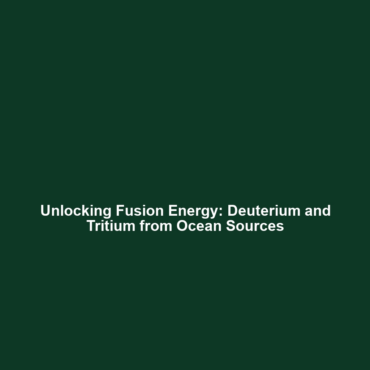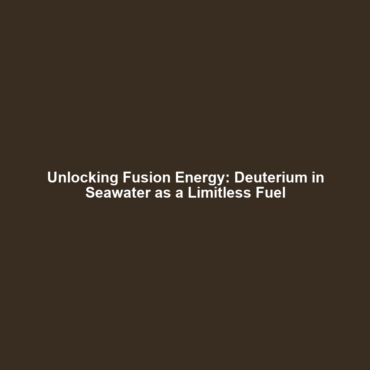Achieving Net Energy Gain in Fusion Energy
Achieving net energy gain is a cornerstone of the quest for sustainable and limitless energy through fusion. By producing more energy than is consumed in the fusion process, scientists aim to unlock an unprecedented energy source that could significantly reduce our dependence on fossil fuels and decrease greenhouse gas emissions. This achievement is crucial in the broader context of fusion energy, which promises a cleaner and virtually inexhaustible supply of energy. Understanding net energy gain is essential for anyone interested in the future of our global energy landscape.
Key Concepts of Achieving Net Energy Gain
Net energy gain in the context of fusion energy refers to the balance between the energy produced by a fusion reaction and the energy required to initiate and sustain that reaction. Key concepts include:
- Fusion Reaction: The process where two light atomic nuclei collide to form a heavier nucleus, releasing a significant amount of energy.
- Threshold Energy: The minimum energy needed to maintain the temperatures and pressures required for fusion to occur.
- Energy Output: The total energy released from the fusion reaction, which must exceed the energy input for net gain.
These principles are integral to understanding how we can achieve net energy gain, allowing fusion to become a viable alternative energy source.
Applications and Real-World Uses
Achieving net energy gain has profound implications for practical applications in fusion energy. Some notable examples of how net energy gain is being pursued within this category include:
- Electricity Generation: Fusion energy provides the potential for cleaner electricity, with continuous operations once net energy gain is realized.
- Hydrogen Production: Fusion can be harnessed to produce hydrogen fuel, offering an alternative energy carrier.
- Space Exploration: Fusion propulsion systems could revolutionize space travel by providing efficient thrust over long distances.
Clearly, the applications of achieving net energy gain in fusion energy can lead to transformative solutions for our time.
Current Challenges
While the pursuit of achieving net energy gain is promising, several challenges remain in the field of fusion energy:
- Technological Barriers: The development of reliable and efficient reactors is still in its infancy.
- Cost of Research: High costs associated with fusion experiments limit the pace of innovation.
- Material Limitations: Finding materials that can withstand the extreme conditions in fusion reactors poses significant issues.
Addressing these challenges of achieving net energy gain is crucial for advancing the field of fusion energy.
Future Research and Innovations
The future of achieving net energy gain in fusion energy looks bright with several promising areas of research and innovation, including:
- Advanced Magnetic Confinement: Researching improved designs for tokamaks and stellarators could enhance energy containment.
- Laser Technology: The use of targeted lasers might improve the efficiency of inertial confinement fusion.
- AI and Machine Learning: These technologies could optimize fusion experiments and predict outcomes more accurately.
Innovations in these areas will play a pivotal role in the upcoming breakthroughs needed for achieving net energy gain.
Conclusion
In summary, achieving net energy gain is fundamental to realizing the full potential of fusion energy. By overcoming existing challenges and harnessing innovative technologies, we can move closer to a future powered by clean, infinite energy sources. To learn more about fusion energy and stay updated on the latest research, consider exploring our additional resources on fusion research and clean energy solutions.


